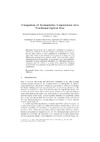Please use this identifier to cite or link to this item:
https://accedacris.ulpgc.es/handle/10553/46858
| DC Field | Value | Language |
|---|---|---|
| dc.contributor.author | Fernández-Caballero, Antonio | en_US |
| dc.contributor.author | Pérez-Jiménez, Rafael | en_US |
| dc.contributor.author | Fernández, Miguel A. | en_US |
| dc.contributor.author | López, María T. | en_US |
| dc.date.accessioned | 2018-11-23T08:56:44Z | - |
| dc.date.available | 2018-11-23T08:56:44Z | - |
| dc.date.issued | 2007 | en_US |
| dc.identifier.isbn | 9783540748175 | en_US |
| dc.identifier.issn | 0302-9743 | en_US |
| dc.identifier.uri | https://accedacris.ulpgc.es/handle/10553/46858 | - |
| dc.description.abstract | Segmentation from optical flow calculation is nowadays a well-known technique for further labeling and tracking of moving objects in video streams. A likely classification of algorithms to obtain optical flow based on the intensity of the pixels in an image is in (a) differential or gradient-based methods and (b) block correlation or block matching methods. In this article, we are going to carry out a qualitative comparison of three well-known algorithms (two differential ones and a correlation one). We will do so by means of the optical flow obtaining method based on accumulated image differences known as accumulative computation. | en_US |
| dc.language | eng | en_US |
| dc.relation.ispartof | Lecture Notes in Computer Science | en_US |
| dc.source | Lecture Notes in Computer Science (including subseries Lecture Notes in Artificial Intelligence and Lecture Notes in Bioinformatics)[ISSN 0302-9743],v. 4692 LNAI, p. 447-454 | en_US |
| dc.subject | 3307 Tecnología electrónica | en_US |
| dc.subject.other | Optical flow | en_US |
| dc.subject.other | Accumulative computation method | en_US |
| dc.subject.other | Image difference | en_US |
| dc.title | Comparison of accumulative computation with traditional optical flow | en_US |
| dc.type | info:eu-repo/semantics/conferenceObject | en_US |
| dc.type | ConferenceObject | en_US |
| dc.identifier.scopus | 38149118942 | - |
| dc.contributor.authorscopusid | 6602230534 | - |
| dc.contributor.authorscopusid | 56044417600 | - |
| dc.contributor.authorscopusid | 57189902279 | - |
| dc.contributor.authorscopusid | 7404124306 | - |
| dc.description.lastpage | 454 | en_US |
| dc.description.firstpage | 447 | en_US |
| dc.relation.volume | 4692 LNAI | en_US |
| dc.investigacion | Ingeniería y Arquitectura | en_US |
| dc.type2 | Actas de congresos | en_US |
| dc.utils.revision | Sí | en_US |
| dc.identifier.ulpgc | Sí | es |
| item.fulltext | Con texto completo | - |
| item.grantfulltext | open | - |
| crisitem.author.dept | GIR IDeTIC: División de Fotónica y Comunicaciones | - |
| crisitem.author.dept | IU para el Desarrollo Tecnológico y la Innovación en Comunicaciones (IDeTIC) | - |
| crisitem.author.dept | Departamento de Señales y Comunicaciones | - |
| crisitem.author.orcid | 0000-0002-8849-592X | - |
| crisitem.author.parentorg | IU para el Desarrollo Tecnológico y la Innovación en Comunicaciones (IDeTIC) | - |
| crisitem.author.fullName | Pérez Jiménez, Rafael | - |
| Appears in Collections: | Actas de congresos | |
SCOPUSTM
Citations
1
checked on Jun 8, 2025
Page view(s)
93
checked on Jan 18, 2025
Download(s)
152
checked on Jan 18, 2025
Google ScholarTM
Check
Altmetric
Share
Export metadata
Items in accedaCRIS are protected by copyright, with all rights reserved, unless otherwise indicated.
